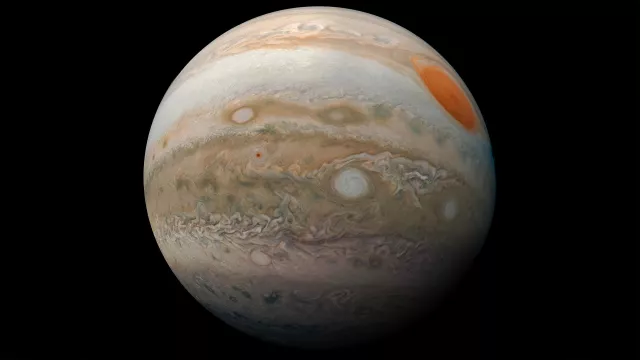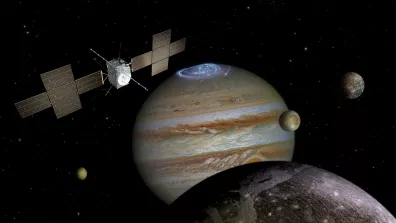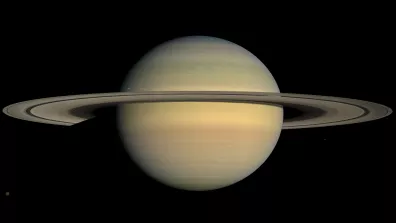Jupiter is the largest and most massive of the planets in the solar system. This gas giant is a stormy and toxic world. But some of its water-bearing moons might just harbour life.
Fast figures
| Distance from Sun | 778 million km (5.2 AU) |
| Volume | 1,431 28 × 1015 km3 (1321.3 Earths) |
| Mass | 1,898,6 × 1024 kg (318 Earths) |
| Diameter | 139,822 km (11 times that of Earth’s) |
| Gravity | 250% that of Earth’s |
| Axial tilt | 3.1° |
| Revolution period | Less than 12 Earth years |
| Rotation period | Less than 10 hours |
| Temperature | –160 °C on average |
| Known moons | 95 |
The gas giant
Jupiter takes its name from the king of the gods in Roman mythology. And indeed, it towers above the eight other planets in our solar system, of which it is the largest and most massive. Spanning 139,822 kilometres, Jupiter could contain more than 1,300 Earths and is two and a half times more massive than all the other planets put together.
- Turbulent early years
This giant of a planet reigns supreme over the solar system. At an average distance of 778 million kilometres (5.2 astronomical units or AU) from the Sun, it’s the fifth planet from our star and the first of the gas giants, with Saturn, Uranus and Neptune.
Jupiter is believed in part to have shaped how the solar system looks today. It’s thought to have formed far from the Sun before migrating inwards and then doing an about-turn under the influence of Saturn, with which it was in orbital resonance (i.e., the two planets’ orbits became locked together). Like a giant planetary billiard ball, it may have disrupted the regions where the inner planets would eventually form, chiefly Mars, and flung a large proportion of the main asteroid belt—between Mars and Jupiter—outside the solar system. As Jupiter reversed course and moved outwards, it could have left room near the Sun for the current telluric planets to form from the rubble left in its wake.
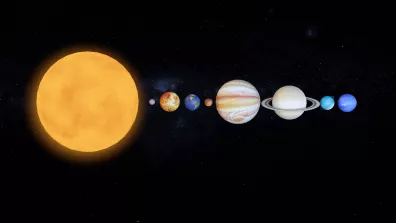
- A ball of gas and liquid
There’s no chance of an astronaut ever setting foot or a rover setting down on the surface of Jupiter. This is because it’s a giant ball of gas composed mainly of hydrogen (H2, about 86%) and a little helium (He, about 13%), methane (CH4, about 0.1%) and water vapour (H2O, 0.1%). The hydrogen making up its thick atmosphere becomes liquid and then metallic deeper down. It has a dilute core of ice and rock.
- Toxic storms
A spacecraft would be obliterated by Jupiter’s storms before it could dive any deeper into this thick layer of gas. The upper layers of the atmosphere are swept permanently by powerful winds that regularly reach speeds of 360 km/h. And as there’s no relief to stop them, the storms that incessantly swirl around the planet can last for years. These storms are what form the colourful belts and white zones. In fact, these colours reveal the presence of chemical elements like sulphur, phosphorus and ammonia. And even if a spacecraft were able to survive the storms and go deeper towards the centre of the planet, it would be crushed by the enormous pressures and vaporized by the extreme temperatures. For while temperatures may be as low as –160°C at the surface, they can reach 20,000°C in the core—much hotter than the surface of the Sun.
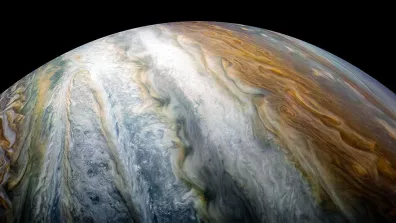
Jovian system exerts strong attraction
Because it’s so massive, Jupiter exerts a strong gravitational pull. This is how it has captured a large number of smaller bodies into its orbit, forming a planetary system all of its own, with more than 95 moons.
- Do the Galilean moons harbour water?
Jupiter has lured many objects into its orbit and has the second largest number of moons in the solar system after Saturn. Four of these moons are the size of a planet and are named after the Italian astronomer Galileo Galilei, who discovered them in 1610. They are:
Io, a volcanically active world.
Europa, the smallest of the four, with a striped icy surface that suggests it’s made of ice floating on liquid water. It also shoots towering plumes above this icy shell.
Ganymede, the largest moon in the solar system and also the only one with a magnetic field. A liquid water ocean may lie beneath its icy surface.
Callisto, with an ancient icy and heavily cratered surface.
Europa, Ganymede and Callisto, the three large icy moons, could harbour large amounts of water. Scientists are seeking to establish if these oceans might be able to support life.

- Invisible rings
Jupiter also has a system of faint planetary rings, albeit less famous and less numerous than those of its neighbour Saturn. There are believed to be three of them, composed of fine dust particles probably ejected from meteorite impacts on the planet’s moons. There are also two groups of asteroids, commonly called the Trojans, in Jupiter’s orbit.
Much left to explore
Several missions have performed flybys of Jupiter since 1973, but only three spacecraft have been sent there specifically to investigate the gas giant and its moons: Galileo (2003), Juno (2022) and JUICE (2023). The first detailed pictures of Jupiter were taken by the U.S. Pioneer 10 and 11 probes, in 1973 and 1974, but it was not until 1995 that a dedicated mission was sent to survey the planet. The U.S. Galileo spacecraft would study Jupiter and its moons up to 2003, detecting liquid water under the surface of Europa and the magnetic field of Ganymede.
Juno, launched in 2011 and arriving in orbit around Jupiter in 2016, has investigated the composition of the gas giant’s atmosphere, measured its gravity field and probed its magnetosphere. The mission’s goal is to attempt to piece together how Jupiter was born and how it helped shaped the solar system. The mission has been extended through to 2025.
- JUICE to look for water on the Galilean moons
In 2023, the European Space Agency (ESA) launched the JUICE (Jupiter Icy Moon Explorer) mission. The European spacecraft is set to reach orbit around Jupiter in 2031, where it will survey the planet, its magnetosphere, rings and multiple moons. But JUICE is above all the first mission with its sights on the planet’s icy moons. The mission plans to collect data on Europa, Ganymede and Callisto, to determine their internal structure and surface composition, study their exosphere, measure the thickness of their icy crust and more.
Ganymede is the mission’s prime target. JUICE will go into orbit around the planet-sized moon for nine months to investigate the upper layers of its surface and its magnetosphere. The spacecraft’s observations of Jupiter and its large icy moons are expected to fill the gaps in our knowledge of how the solar system formed, how the planets were born and how life emerged.
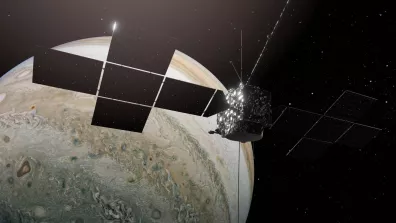
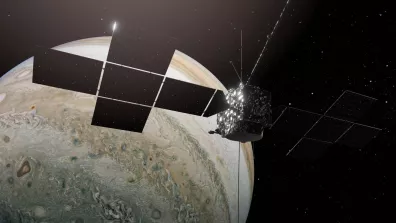
Quiz
Io, Europa, Ganymede and Callisto, Jupiter’s four main moons, were discovered in 1610 by:


